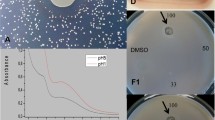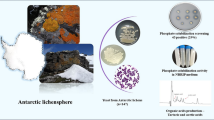Abstract
In previous studies it was found that the antimicrobial properties of pulcherrimin-producing Metschnikowia species are related to the formation of a red pigment—pulcherrimin and sequestration of free iron from their growth medium. For strains of Metschnikowia pulcherrima, M. sinensis, M. shaxiensis, and M. fructicola, at a high, ≈80 mg/kg, elemental Fe concentration in agar growth media we observed the essentially different (metal luster, non-glossy rust like, and colored) yeast biomass coatings. For the studied strains the optical and scanning electron microscopies showed the increased formation of chlamydospores that accumulate a red pigment—insoluble pulcherrimin rich in iron. The chlamydospore formation and decay depended on the iron concentration. In this study pulcherrimin in biomass of the selected Metschnikowia strains was detected by Mössbauer spectroscopy. At ≈80 mg/kg elemental Fe concentration the Mössbauer spectra of biomass of the studied strains were almost identical to these of purified pulcherrimin. Iron in pulcherrimin reached ≈1% of biomass by weight which is very high in comparison with elemental Fe percentage in growth medium and is not necessary for yeast growth. The pulcherrimin in biomass was also observed by Mössbauer spectroscopy at lower, ≈5 mg/kg, elemental Fe concentration. Through chemical binding of iron pulcherrimin sequestrates the soluble Fe in the growth media. However, at high Fe concentrations, the chemical and biochemical processes lead to the pulcherrimin accumulation in biomass chlamydospores. When soluble iron is sequestrated or removed from the growth media in this way, it becomes inaccessible for other microorganisms.
Graphic abstract


taken from places shown by numbers in (a1); c1 M10 and M.p. at 5 mg/kg elemental Fe concentration after 22 h and c2 4 days; d1 M10 at 22 mg/kg elemental Fe concentration after 20 days and Liesegang rings of pulcherrimin around biomass, growth medium thickness is 2–3 mm; d2 same medium, biomass washed from the surface; e M4, M6, M7 (M. pulcherrima) and M10 strains at ≈80 mg/kg elemental Fe concentration after 22 h, and f scheme of biomass coatings accumulating pulcherrimin






Similar content being viewed by others
References
Neilands JB (1995) Siderophores: structure and function of microbial iron transport compounds. J Biol Chem 270:26723–26726
Renshaw JC, Robson GD, Trinci APJ, Wiebe MG, Livens FR, Collison D, Taylor RJ (2002) Fungal siderophores: structures, functions and applications. Mycol Res 106:1123–1142
Templeton D (ed) (2002) Molecular and cellular iron transport. Marcel Dekker, New York
Krause DJ, Kominek J, Opulente DA, Shen X-X, Zhou X, Langdon QK, DeVirgilio J, Hulfachor AB, Kurtzman CP, Rokas A, Hittinger CT (2018) Functional and evolutionary characterization of a secondary metabolite gene cluster in budding yeasts. PNAS 115:11030–11035
MacDonald JC (1963) The structure of pulcherriminic acid. Can J Chem 41:165–172
Sipiczki M (2020) Metschnikowia pulcherrima and related pulcherrimin-producing yeasts: fuzzy species boundaries and complex antimicrobial antagonism. Microorganisms 8:1029
Kluyver AJ, Walt JP, Triet AJ (1953) Pulcherrimin, the pigment of Candida pulcherrima. PNAS 39:583–593
Cook AH, Slater CA (1954) Metabolism of “wild” yeasts I. The chemical nature of pulcherrimin. J Inst Brew 60:213–217. https://doi.org/10.1002/j.2050-0416.1954.tb06226.x
Canale-Parola E (1963) A red pigment produced by aerobic sporeforming bacteria. Archiv für Mikrobiologie 46:414–427
Wang D, Zhan Y, Cai D, Li X, Wang Q, Chen S (2018) Regulation of the synthesis and secretion of the iron chelator cyclodipeptide pulcherriminic acid in Bacillus licheniformis. Appl Environ Microbiol 84:e00262-e318
Cryle MJ, Bell SG, Schlichting I (2010) Structural and biochemical characterization of the cytochrome P450 CypX (CYP134A1) from Bacillus subtilis: a cyclo- L -leucyl- L -leucyl dipeptide oxidase. Biochemistry 49:7282–7296
Sipiczki M (2006) Metschnikowia strains isolated from botrytized grapes antagonize fungal and bacterial growth by iron depletion. Appl Environ Microbiol 72:6716–6724
Kupfer DG, Uffen RL, Canale-Parola E (1967) The role of iron and molecular oxygen in pulcherrimin synthesis by bacteria. Archiv für Mikrobiologie 56:9–21
Wésolowski-Louvel M, Breuning KD, Fukuhara H (1996) Kluyveromyces lactis. In: Wolf K (ed) Non conventional yeasts in biotechnology. Springer Verlag, Berlin Hidelberg, pp 138–201
Li X, Wang D, Cai D, Zhan Y, Wang Q, Chen S (2017) Identification and high-level production of pulcherrimin in Bacillus licheniformis DW2. Appl Biochem Biotechnol 183:1323
Janisiewicz WJ, Tworkoski TJ, Kurtzman CP (2001) Biocontrol potential of Metschnikowia pulcherrima strains against blue mold of apple. Phytopathology 91:1098–1108
Spadaro D, Gullino ML (2004) State of the art and future prospects of the biological control of postharvest fruit diseases. Int J Food Microbiol 91:185–194
Saravanakumar D, Ciavorella A, Spadaro D, Garibaldi A, Gullino ML (2008) Metschnikowia pulcherrima strain MACH1 outcompetes Botrytis cinerea, Alternaria alternate and Penicillium expansum in apples through iron depletion. Postharvest Biol Technol 49:121–128
Turkel S, Ener B (2009) Isolation and characterization of new Metschnikowia pulcherrima strains as producers of the antimicrobial pigment pulcherrimin. Zeitschrift für Naturforschung C 64:405–410
Csutak O, Vassu T, Sarbu I, Stoica I, Cornea P (2013) Antagonistic activity of three newly isolated yeast strains from the surface of fruits. Food Technol Biotechnol 51:70–77
Oro L, Ciani M, Comitini F (2014) Antimicrobial activity of Metschnikowia pulcherrima on wine yeasts. J Appl Microbiol 116:1209–1217
Kantor A, Hutkova J, Petrova J, Hleba L, Kacaniova M (2015) Antimicrobial activity of pulcherrimin pigment produced by Metschnikowia pulcherrima against various yeast species. J Microbiol Biotechnol Food Sci 5:282–285
Melvydas V, Svediene J, Skridlaite G, Vaiciuniene J, Garjonyte R (2020) In vitro inhibition of Saccharomyces cerevisiae growth by Metschnikowia spp. triggered by fast removal of iron via two ways. Brazil J Microbiol 51:1953–1964
Kurtzman CP, Fell JW, Boekhout T (2011) The yeasts, a taxonomic study, 5th edn. Elsevier, Amsterdam
Cockrell AL, Holmes-Hampton GP, McCormick SP, Chakrabarti M, Lindahl PA (2011) Mössbauer and EPR study of iron in vacuoles from fermenting Saccharomyces cerevisiae. Biochemistry 50:10275–10283
Park J, McCormick SP, Cockrell AL, Chakrabarti M, Lindahl PA (2014) High-spin ferric ions in Saccharomyces cerevisiae vacuoles are reduced to the ferrous state during adenine-precursor detoxification. Biochemistry 53:3940–3951
Pitt JI, Miller MW (1968) Sporulation in Candida pulcherrima, Candida Reukaufii and Chlamydozyma species: their relationships with Metschnikowia. Mycologia 60:663–685
Lachance M-A (2016) Metschnikowia: half tetrads, a regicide and the fountain of youth. Yeast 33:563–574
Kurtzman CP, Boekhout T, Robert V, Fell JW, Deak T (2003) Methods to identify yeasts. In: Boekhout T, Robert V (eds) Yeasts in food. Benificial and detrimental aspects. Behr’s Verlag, Hamburg, pp 69–121
Chen Y-L, Yang D-P (2007) Mössbauer effect in lattice dynamics. Wiley-VCH Verlag GmbH & Co KGaA, Weinheim
Christides T, Sharp P (2013) Sugars increase non-heme iron bioavailability in human epithelial intestinal and liver cells. PLoS ONE 8:e83031
Melvydas V, Staneviciene R, Balynaite A, Vaiciuniene J, Garjonyte R (2016) Formation of self-organized periodic patterns around yeasts secreting a precursor of a red pigment. Microbiol Res 193:87–93
Racz Z (1999) Formation of Liesegang patterns. Phys A 274:50–59
Karpati-Smidroczki E, Büki A, Zrínyi M (1995) Pattern forming precipitation in gels due to coupling of chemical reactions with diffusion. Colloid Polym Sci 273:857–865
Raymond KN, Allred BE, Sia AK (2015) Coordination chemistry of microbial iron Transport. Acc Chem Res 48:2496–2505
Matzanke BF, Bill E, Trautwein AX, Winkelmann G (1987) Role of siderophores in iron storage in spores of Neurospora crassa and Aspergillus ochraceus. J Bacteriol 169:5873–5876
Matzanke BF, Winkelmann G (1981) Siderophore iron transport followed by Mössbauer Spectroscopy. FEBS Lett 130:50–53
Matzanke BF, Ecker DJ, Yang T-S, Huynh BH, Müller G, Raymond KN (1986) Escherichia coli iron Enterobactin uptake monitored by Mössbauer spectroscopy. J Bacteriol 167:674–680
Matzanke BF, Berner I, Bill I, Trautwein AX, Winkelmann G (1991) Transport and utilization of ferrioxamine-E-bound iron in Erwinia herbicola (Pantoea agglomerans). Biol Metals 4:181–185
Matzanke BF, Möllmann U, Reissbrodt R, Schünemann V, Trautwein AX (1998) Siderophore transport in mycobacteria analyzed by Mössbauer spectroscopy: Possible routes to novel antibiotics against these organisms? Hyperfine Interact 112:123–128
Vertes A, Nagy DL (eds) (1990) Mössbauer spectroscopy of frozen solutions. Akadémiai Kiadó, Budapest
Acknowledgments
This research did not receive any specific grant from funding agencies in the public, commercial, or not-for-profit sectors. The authors are grateful to Z. Kuodis for the FT-IR spectra and to R. Juškėnas for XRD data.
Author information
Authors and Affiliations
Corresponding author
Ethics declarations
Conflict of interest
The authors declare no conflict of interest.
Additional information
Publisher's Note
Springer Nature remains neutral with regard to jurisdictional claims in published maps and institutional affiliations.
Supplementary Information
Below is the link to the electronic supplementary material.
Rights and permissions
About this article
Cite this article
Mažeika, K., Šiliauskas, L., Skridlaitė, G. et al. Features of iron accumulation at high concentration in pulcherrimin-producing Metschnikowia yeast biomass. J Biol Inorg Chem 26, 299–311 (2021). https://doi.org/10.1007/s00775-021-01853-z
Received:
Accepted:
Published:
Issue Date:
DOI: https://doi.org/10.1007/s00775-021-01853-z




